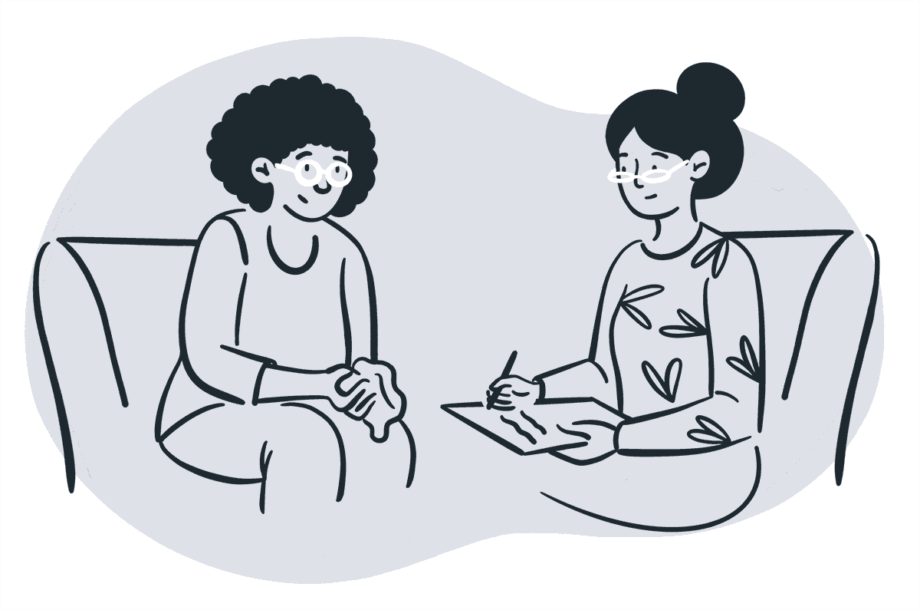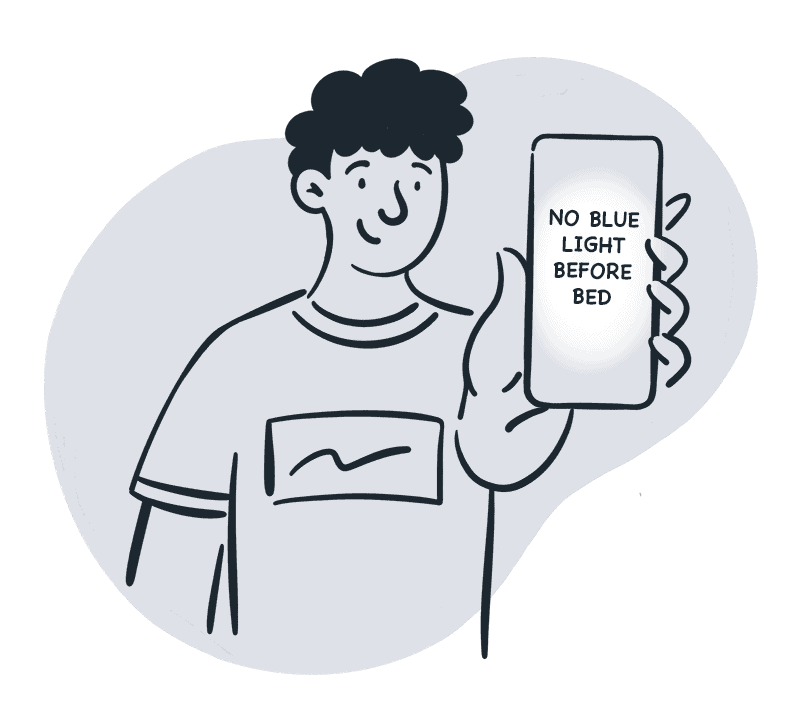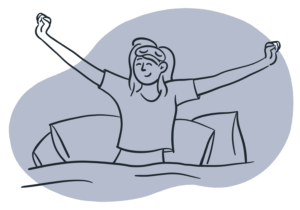Sleep and Anxiety
Disclosure: By clicking on the product links in this article, Mattress Nerd may receive a commission fee at no cost to you, the reader. Read full disclosure statement.
Mattress Nerd consulted Dr. Steven Bradley, MD to ensure that this article met our editorial standards
Imagine peacefully walking down a nature trail when suddenly you come face-to-face with a bear. In a moment’s notice you jump to a 10 out of 10 on the panic scale. Adrenaline rushes into your bloodstream triggering your body’s “fight or flight” response. Your heart pounds. Your breathing increases. You may even begin to tremble.
Now imagine suddenly feeling that way in situations that shouldn’t frighten you, such as walking into a grocery store or into an elevator. Or having a less intense yet uncomfortable and persistent feeling that something awful was about to happen. Or thinking disease-causing germs were all over your hands but no amount of washing them can get rid of them. These are the many faces of anxiety.
It’s normal to feel anxious from time to time, or even to feel a jolt of fear when you’re confronted with something frightening. But when that feeling persists, becomes overwhelming, and interferes with your life and your sleep, it becomes an anxiety disorder.
Anxiety disorders are the most common mental illness in the United States, affecting 40 million adults in America, according to the Anxiety & Depression Association of America. A person’s risk of developing an anxiety disorder depends on a number of factors including genetics, brain chemistry, their personality, and life events. As debilitating as the symptoms can be, anxiety is highly treatable. Yet, only about a third of those who suffer from the condition seek treatment.
The excessive worry and intrusive thoughts often worsen before bedtime, says Brooke Aymes, a New Jersey-area licensed mental health professional specializing in anxiety at Gaining Grace LLC. And this can sabotage your sleep by making it difficult to fall asleep at bedtime or cause you to wake during the night.
 Concerningly, “sleep deprivation and unregulated hormones can cause an individual to be more sensitive to emotional triggers, provoking mental disorders,” leading to a seemingly never-ending cycle, says Amerisleep’s Spencer Institute Certified Sleep Science Coach McKenzie Hyde.
Concerningly, “sleep deprivation and unregulated hormones can cause an individual to be more sensitive to emotional triggers, provoking mental disorders,” leading to a seemingly never-ending cycle, says Amerisleep’s Spencer Institute Certified Sleep Science Coach McKenzie Hyde.
Common Anxiety Disorders
Not everyone expresses anxiety the same way. As such, there are several types of anxiety disorders. Some of the most common include generalized anxiety disorder, obsessive compulsive disorder, panic disorder, post-traumatic stress disorder (PTSD), social anxiety disorder, and even phobias.
Generalized Anxiety Disorder
About 6.8 million adults — most often women — suffer from general anxiety disorder, or GAD. It’s identified as excessive anxiety or worry that lasts for at least six months. The worry can be about anything from personal health or finances, to work or social interactions. The condition often occurs along with depression.
Symptoms of GAD include:
- Restlessness or feeling on-edge
- Fatigue
- Difficulty concentrating
- Irritability
- Muscle tension
- Excessive worry
- Sleep problems
Obsessive Compulsive Disorder
Only about 1 percent of the adult population — or 2.2 million people — suffers from obsessive compulsive disorder, or OCD. People with this type of anxiety disorder have reoccurring, uncontrollable, and disturbing thoughts, urges, or mental images (known as obsessions) that cause anxiety. To quell these obsessions, those with OCD feel compelled to repeat certain behaviors, actions, or rituals (known as compulsions).
Obsessions and compulsions often follow certain themes. Some of the most common include:
- Obsessions about germs or dirt that result in compulsions of washing hands until the skin is rubbed raw.
- Obsessing about having things lined up perfectly symmetrical with compulsions to constantly order and redo them.
Sometimes people with OCD feel compelled to do certain rituals such as count in certain patterns or silently repeat a prayer, word, or phrase believing doing these things will help prevent something bad from happening. However, these acts bring no pleasure and only provide temporary relief to their nagging anxiety.
Panic Disorder
About six million adults suffer from panic disorder. People with this condition experience recurrent, unexpected panic attacks during which they experience sudden jolts of intense fear. The attacks come on unexpectedly and often without a trigger.
Symptoms often experienced during a panic attack include:
- Pounding heart or accelerated heart rate
- Sweating
- Trembling or shaking
- A sensation of choking or being short of breath
- Feelings of impending doom
- Feeling like you’re about to die or act out hysterically
When the initial fear subsides, people may experience a lingering worry about when the next attack will occur. Often, they will avoid places, situations, or behaviors they associate with panic attacks in an effort to prevent another from happening. If someone who suffers from panic attacks begins to avoid situations out of fear of having another panic attack, they may develop agoraphobia, a fear of being in open spaces or out in public.
PTSD
Post-traumatic stress disorder (PTSD) is an enormously painful and sometimes debilitating condition. People with this disorder suffer severe anxiety coupled with intense disturbing thoughts and emotions associated with a trauma they experienced or witnessed that lasts long after the event has ended. Situations that can trigger PTSD include war, rape, serious accidents, natural disasters and being a victim of a violent attack. About 7.7 million people in the U.S. have PTSD.
Symptoms of PTSD are often grouped into four types:
- Intrusive memories
- Recurrent, unwanted distressing memories of the traumatic event
- Flashbacks of the trauma
- Nightmares
- Severe emotional distress or physical reactions to triggers
- Avoidance
- Trying to avoid talking or thinking about the event
- Avoiding people, places, or activities that remind them of the event
- Negative changes in thinking and mood
- Negative thoughts about oneself or the world around them
- Feelings of hopelessness
- Memory problems
- Difficulty maintaining relationships
- Feeling detached from others
- Lack of interest in activities once enjoyed
- Feeling emotionally numb
- Changes in physical and emotional reactions
- Being easily startled and always on guard for danger
- Self destructive behavior such as driving too fast or drinking too much
- Difficulty sleeping
- Trouble concentrating
- Irritability or aggressive behavior
- Feeling overwhelming guilt or shame
Social Anxiety Disorder
Once referred to as social phobia, social anxiety disorder is a condition in which someone has an intense fear of social or performance situations. The anxiety is usually rooted in an intense worry that one’s actions or behaviors will be negatively viewed by others and cause them embarrassment. People with social anxiety tend to avoid social situations. About 15 million people in the U.S. have some degree of social anxiety — about twice as many as those who suffer from general anxiety disorder, panic disorder, or PTSD.
Various specific phobias
A phobia is an intense irrational fear reaction to a specific place, situation, or object, such as elevators, public speaking, or snakes. People with phobias know their fears are irrational but are unable to overcome the fear. As a result, they may be cautious or avoid the thing they are afraid of. Phobias can range from mild to disabling to the point they interfere with daily activities. About 19 million people suffer from some type of phobia.
Phobia symptoms include:
- Irrational or excessive worry about encountering a certain place, situation, or object
- Making efforts to avoid the certain place, situation, or object
- Having an immediate intense anxiety upon encountering the feared place, situation, or object
There are numerous types of phobias. Some examples include:
- Elevators or closed-in spaces
- Flying or heights
- Specific animals such as spiders, snakes, or dogs
- The sight of blood

The Reciprocal Relationship Between Sleep and Anxiety
“Sleep is the key to being and staying healthy,” says Jason Reed, PharmD, creator of BestRxforSavings.com. “It is the time when our bodies repair and rebuild the damage that happens to our system throughout the day.” Unfortunately, anxiety can sabotage sleep.
“When you’re in a hyper-aroused state your body and mind are on the lookout for threats, this can make you more likely to react to external stimuli, reducing the quality of your sleep,” says Katherine Hall, a sleep psychologist and a sleep coach at Somnus Therapy, an online sleep therapy program. “The sharpened senses and high alert state can also make you more inclined to wake up in response to a low-level noise or slight movements which you would normally sleep through.”
Insufficient sleep can also be a trigger for anxiety, creating a “vicious cycle,” Reed says. According to research published in the journal Sleep, there is a bidirectional relationship between sleep disturbances and anxiety, as well as depression, suggesting that each contributes to the development and are a consequence of one another.
“Unfortunately, once you’ve experienced a few night’s of restless sleep and are already feeling anxious and worried, insomnia only adds fuel to the fire. You may become irritable, more stressed and even worried about not being able to sleep, which further increases anxiety and stress.” Hall adds.
How to Beat Anxiety for Better Sleep
Getting a good night’s sleep can help you manage your anxiety. But when you are feeling anxious, getting good sleep can feel insurmountable. But it’s not impossible. Practicing good sleep hygiene and adopting a few lifestyle changes can greatly improve your sleep quality.
Improve your Sleep Hygiene
Sleep hygiene is a form of personal hygiene that involves behavioral and environmental practices designed to improve your sleep. Here are several recommendations you can use to better your sleep hygiene:
Create a consistent night routine.
“My top tip to improve sleep quality is to perform a relaxing pre-bedtime routine,” says Stephen Light, a certified sleep science coach and co-owner of Nolah Mattress. Establishing a regular bedtime and nightly routine about 30 minutes to an hour before bedtime helps train your body for sleep. For example, do soothing activities such as taking a warm bath, reading a book, doing stretches, or listening to a mellow playlist. “The goal of performing these is to clear the mind of any anxious thoughts, helping the body transition to a relaxed state that is more conducive for sleeping,” Light adds.
Create a consistent morning routine.
Establishing a regular time to awaken each morning as well as a regular morning routine can also help train your body to wake up more naturally in the morning, improve your sleep, and help prepare you for the day ahead. Be sure to wake up early enough so that you aren’t rushed in the morning. Some morning routine activities include drinking a glass of water before your cup of coffee, doing yoga poses or stretches, and meditating or doing relaxation exercises.
Create a sleep environment conducive for sleep.
Your bedroom should be a sanctuary conducive to sleep. Block out unwanted light with blackout curtains, use a sound machine to mask outside noises, relax with your weighted blanket, set your thermostat a few degrees cooler than you have it during the daytime hours, and be sure your pajamas and bed linens are clean, soft and breathable.
Invest in a new mattress.
You’d be surprised the difference a comfortable and supportive mattress makes. A new mattress made with memory foam, latex, or a hybrid that combines foam with innerspring coils can provide contouring comfort as well as pressure point relief that can soothe the body and, in turn, the mind.
Cut out blue light.
 Blue light is the light that emits from electronic devices such as smartphones, TVs, tablets, and computers. Blue light stimulates the brain, which is great during the day when you need to stay alert. But it can prevent you from falling asleep. Try to unplug from these devices at least 30 minutes to an hour before bedtime.
Blue light is the light that emits from electronic devices such as smartphones, TVs, tablets, and computers. Blue light stimulates the brain, which is great during the day when you need to stay alert. But it can prevent you from falling asleep. Try to unplug from these devices at least 30 minutes to an hour before bedtime.
Cut out stimulants before bedtime.
Caffeine and sugar are stimulants and can keep you awake at night if you enjoy them too close to bedtime. Try not to consume caffeine three to six hours before bedtime, and try to resist eating dessert less than an hour before bed.
Limit your alcohol intake.
Alcohol is a depressant, which can help you fall asleep at night. But one too many drinks can actually interfere with restorative REM and deep sleep. This not only prevents you from waking refreshed in the morning, it can also force you awake in the middle of the night and make it difficult to get back to sleep. Plus, too much alcohol late at night can leave you especially anxious the next morning.
Try natural sleep aids to help.
Natural sleep aids, such as lavender-scented essential oils, a cup of camomile tea, or melatonin supplements, can also calm your mind and help you fall asleep at night.
Try Making some Lifestyle Changes
Adopting a few lifestyle changes can greatly reduce your stress and anxiety and improve your sleep. Here are some suggestions:
Exercise for at least 30 minutes a day.
Research has shown that regular aerobic exercise can decrease tension, elevate mood, and improve sleep. According to the Anxiety & Depression Association of America, as little as five minutes of aerobic exercise can trigger the release of endorphins — chemicals in the brain that act like natural painkillers — and stimulate anti-anxiety effects. The release of endorphins and adrenaline also reduces fatigue and improves alertness, which is great during the day when you need to concentrate on work or school, but not so great at bedtime when you’re trying to fall asleep. So, be sure to exercise a couple hours before bedtime to give your body and mind time to wind down.
Try relaxation exercises.
Relaxation exercises are an excellent way to settle an anxious mind and body in order to prepare yourself for sleep. Some examples include breathing exercises, yoga stretches, meditation, or acupressure techniques. “If you have anxiety, learning to meditate can be a great way to calm the nerves,” Reed says. “Similarly, deep breathing can stimulate the parasympathetic nervous system, which triggers opposing functions vs. the sympathetic nervous systems.”
Try mindfulness techniques.
“Mindfulness focuses on engaging all of your senses and being grounded in the present, rather than worrying about the past or future,” Hall says. “Mindfulness has so many benefits, including being wonderful for stress reduction. We know that stress can hinder sleep, it’s easy to see how mindfulness can be so useful when it comes to sleeping better.”
Mindfulness can also help shift perspective, enabling you to “let go” of your worries which, in turn, improves sleep. One mindfulness technique involves lying down on your bed and focusing on your breathing and your body as it sinks into your mattress. Mentally scan each part of your body, starting with your toes then feet then lower legs, all the way up to your head. Pay attention to the sensations in each part of your body. Counter tension with relaxation and anxiety with soothing images or mantras.
Set aside worry time.
Keep a pen and paper beside your bed. “If things come through your mind, write them down so you can stop thinking about them,” Reed suggests. Another option is actually setting aside 15-20 minutes in your day to worry. “Thoughts that interfere at bedtime will be a lot easier to dismiss if they have already been dealt with at a time when you’re much more awake,” Hall says.
Seek therapy and/or medication.
If you suffer from anxiety and it is interfering with your daily activities and impeding your sleep, talk with a medical or mental health professional to determine the best approach to overcoming your distress. Your doctor may recommend therapy or medication. Cognitive behavioral therapy is the most widely used therapy for anxiety disorders and has been shown to be effective at treating panic disorders, phobias, social anxiety, general anxiety, and PTSD. Some medications used to treat anxiety include antidepressants like Lexapro and Luvox, or anti-anxiety medication like Xanxa or Klonopin.
Final Thoughts
Anxiety is the most common mental illness in the United States. Many people can manage their symptoms, but for some, it can become debilitating, interfering with daily activities and disrupting sleep. When anxiety begins to interfere with sleep, it can exacerbate anxiety symptoms.
Rest assured that anxiety is highly treatable, but it may require professional help. If your symptoms become overwhelming, contact a medical or mental health professional, or the Substance Abuse and Mental Health Services Administration’s free, confidential 24/7, 365-day-a-year National Helpline at 1-800-662-HELP (4357).
“It is important to be proactive about our mental health,” Aymes says, “and important to practice taking care of ourselves to control what we can to help alleviate mental health symptoms and to ultimately feel better.”
Additional Resources
- National Institute of Mental Health
- Anxiety & Depression Association of America
- American Academy of Child & Adolescent Psychiatry
Meet Our Medical Reviewer
Dr. Steven Bradley, MD
Dr. Steven Bradley is an anesthesiologist and professor of anesthesiology at Uniformed Services University of Health Sciences. He also created and hosts The Black Doctors podcast where he interviews minority professionals in a variety of different career paths to provide mentorship and inspiration.


